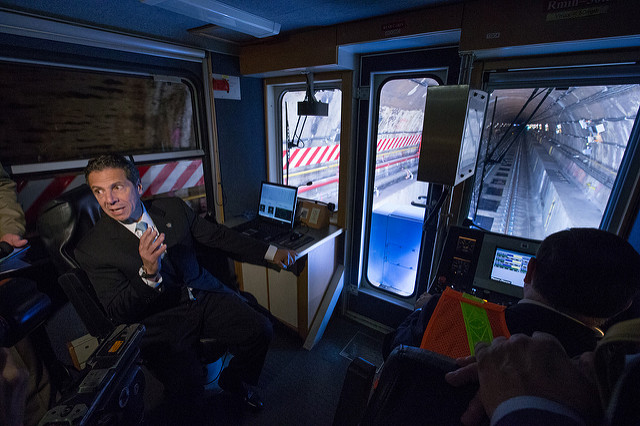
(photo: governor's office)
My organization, Reinvent Albany, strongly supports congestion pricing and new revenue for the MTA, but we believe the MTA’s biggest organizational problem is the Governor’s endless political meddling and sidelining of the MTA’s and New York City Transit’s (NYCT) professional staff.
We hope the hastily contrived MTA restructuring recently presented by Governor Andrew Cuomo and Mayor Bill de Blasio in their “10-Point Plan to Transform and Fund the MTA” withers under public scrutiny and is rejected by the State Legislature and key county stakeholders in the MTA region. This is not real reform: it is a counter-productive distraction that continues the politicization of the MTA, and even codifies it.
Transit riders and those interested in a functioning system should stay focused on the 2016 pledge of Governor Cuomo and the Legislature to give the MTA 2015-2019 Capital Plan $8.3B, with $1B appropriated upfront. The governor and Legislature still owe $7.3B. Where is this money? To date, the MTA has received only $805 million from the state in cash it can actually spend on the current plan. We are especially concerned Governor Cuomo is about to renege on his $8.3B pledge because new revenue from congestion pricing will go to the next MTA capital plan – the 2020-2024 plan.
Reinvent Albany strongly supports congestion pricing for the Manhattan Central Business District and we thought Sam Schwartz’s Move New York plan was a masterpiece of public policy, but we have numerous concerns about the new 10-point plan from the governor and the mayor. Here are five big ones:
First, highly-respected NYCT President Andy Byford is stripped of power (Item #1). The governor’s proposed reorganization takes away a huge amount of fundamental management authority from New York City Transit President Andy Byford and shifts it to MTA Headquarters (HQ). We wonder what happens with Byford’s Fast Forward Plan if he can’t implement it? The governor proposes shifting engineering, contracting and construction management to MTA HQ. Why? NYCT just hired Pete Tomlin, an internationally respected expert, to lead NYCT in modernizing the subway signals, a cornerstone of Byford’s plan. What happens to this hire? MTA HQ has completely mismanaged the East Side Access project with up to $7B in cost overruns.
Second, the Cuomo plan creates new loopholes in the congestion pricing plan by creating vague exceptions for motorists (Item #2). Given the disastrous experience with state and New York City issued parking placards, the public should be concerned about the potential of these loopholes to be abused by politically powerful groups.
Third, what happens to the MTA if inflation is higher than 2%? (Item #3). A two-percent hard cap on MTA fare and toll hikes makes no sense. More reasonable would be to index to inflation, since inflation has historically regularly exceeded 2%.
Fourth, the proposed Regional Transit Committee duplicates and subtracts from the MTA Board’s authority and will create even more confusion (Item #7). If the Legislature wants representation on the MTA board or changes to the board, it should make them instead of creating a confusing mess that further reduces accountability. Moody’s – one of the MTA’s credit raters, which typically issues muted statements – even said that the this plan “will not necessarily reduce the management complexity that has complicated fare increases and capital program approval.” The MTA board should determine fares, tolls, and budgets, etc. If it does it poorly, reform it.
Fifth, the MTA, like other state authorities and agencies, should be run by professionals, not overseen by arbitrarily selected academics hand-picked by the governor (Item #8). There are many people in the world with more far more expertise in transit engineering and technology than the deans of Columbia and Cornell engineering schools – including within the MTA, like NYCT’s new hire, Pete Tomlin. Why should these informal advisors to the governor determine what kind of signals technology the MTA uses?
This is not the time to make major changes to redistribute power over the MTA’s governance structure, as there are too many stakeholders at risk. Changes to the governance of the MTA should be made independently of the budget after full and thorough discussion by MTA stakeholders and the public - something that we can truly call reform.
***
Rachael Fauss is Senior Policy Analyst at Reinvent Albany. On Twitter @RachaelFauss & @ReinventAlbany.
***
Have an op-ed idea or submission for Gotham Gazette? Email This email address is being protected from spambots. You need JavaScript enabled to view it.




